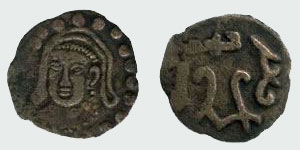
Coins of Ferghana with images and descriptions
History of Ferghana
Ferghana. It’s a name commonly used to describe the Syr-Darya valley, closed in by the Tien Shan Mountains and extending for 300 km, with a width of up to 150 km. Ferghana represents a separate state union, which in Chinese sources carried a name of “Davan”, and during the entire ancient period retained its independence.

The Ferghana valley was already settled during the Stone Age. During the Bronze Age tribes of different economic systems lived here, herdsmen and farmers. Information about Ferghana in 2d – 1st centuries B.C. is much more plentiful than about prior or future historical periods. Thanks to the records of the Chinese ambassador of Zhan Zang, who had visited Ferghana, and historical records related to the Chinese military campaigns in 104 and 101 B.C. after the famous “celestial horses, which perspire with blood”.
They pointed out 70 large and small cities, “the sovereign was located in the city Gushan”. The population of Feghana was determined at 300,000 people (or 60,000 soldiers). The Chinese also noted that the local inhabitants “did not know how to cast coins”. During the early medieval period Ferghana was named in written sources as Bahan, Pahana, Feihan. The rulers possessed a local title of “ishkhid” The most important event of the following historical period, which influenced the future history of Ferghana, as well as the entire Central Asia, was the invasion of the Turks, who in the middle of the 6th century A.D. subjected lands ranging from China to the “Iron Gates” (the Derbent gorge).
Between 627 and 649 A.D., Turks came to power in Ferghana. The independent casting of Ferghana’s coins likely started during this period. The city of Kasan is being named as the residence of the ruler. In the 7th century, based on Chinese sources (Tan Shu, records of 754 A.D.), Ferghana had 6 large and 100 small cities. According to the same source, the local dynasty ruled uninterrupted from 3d to 7th century A.D.. The conquest of Ferghana by the Arabs, which began with a campaign of 713 A.D. by Quteiba b. Muslim, lasted for over 100 years, until it’s final conquest.
Coins catalog of Ferghana
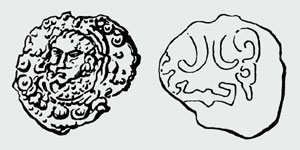
Fr1. With the name Farnbaga.
VII-VIII centuries Obverse: Head of a deity, three-quarters to the left.
The face is made in a manner characteristic of Buddhist iconography. Reverse: In the field there is a lyre-shaped tamga sign, around a Sogdian legend. ( # 41 O.I. Smirnova, Union catalogue…, # 1434 ). Bronze.
/ Extremely Rare /

Fr2. Unknown ruler.
VII-VIII centuries Obverse: Head of a deity, three-quarters to the left. Reverse: In the field there is a lyre-shaped tamga sign, around a Sogdian legend. ( # 41 O.I. Smirnova, Union catalogue…, # 1480 ). Bronze.
D-23 mm.
Weight – 2.5 grams.
/ Extremely Rare /
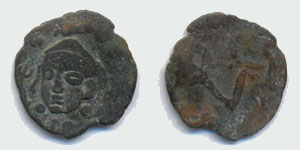
Fr3. Unknown ruler.
VII-VIII centuries Obverse: Head of a deity, three-quarters to the left. Reverse: In the field there is a lyre-shaped tamga sign, around a Sogdian legend. ( # 41 O.I. Smirnova, Union catalogue…, # 1472 ). Bronze.
/ Extremely Rare /
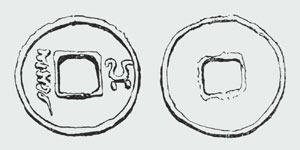
Fr4. Nameless hakans.
VIII centuries Obverse: To the right of the square hole is a lyre-shaped tamga sign.
On the left is the inscription in Sogdo-Turkic semi-cursive script “Khakan”. Reverse: Smooth. ( # 41 O.I. Smirnova, Union catalogue…, # 1435 ). Bronze.
/ Very Rare /
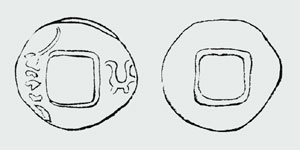
Fr5. Nameless hakans.
VIII centuries Obverse: To the right of the hole is a lyre-shaped tamga sign.
On the left is the inscription in Sogdo-Turkic semi-cursive script “Khakan”. Reverse: Smooth. ( # 41 O.I. Smirnova, Union catalogue…, # 1439 ). Bronze.
/ Very Rare /

Fr6. Nameless hakans.
VIII centuries Obverse: To the right of the hole is a stylized lyre-shaped tamga sign, to the left is an inscription of one word “khakan”. Reverse: Below, under the square hole, there is an inscription in Sogdo-Turkic semi-cursive script “Alga”. ( # 41 O.I. Smirnova, Union catalogue…, # 1440 ). Bronze.
/ Very Rare /
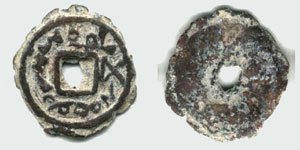
Fr7. Tutuki in Fergana.
VIII centuries Obverse: In the field around the square hole there is a Sogdian legend, the runic “ash” is inscribed on the right. Reverse: Smooth. ( # 41 O.I. Smirnova, Union catalogue…, # 1445 ). Bronze.
D-17 mm.
Weight 1.8 grams.
/Rare/
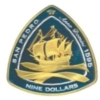




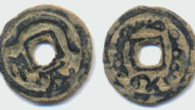
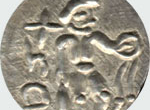
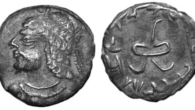
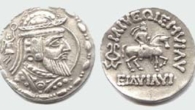
Leave a Reply